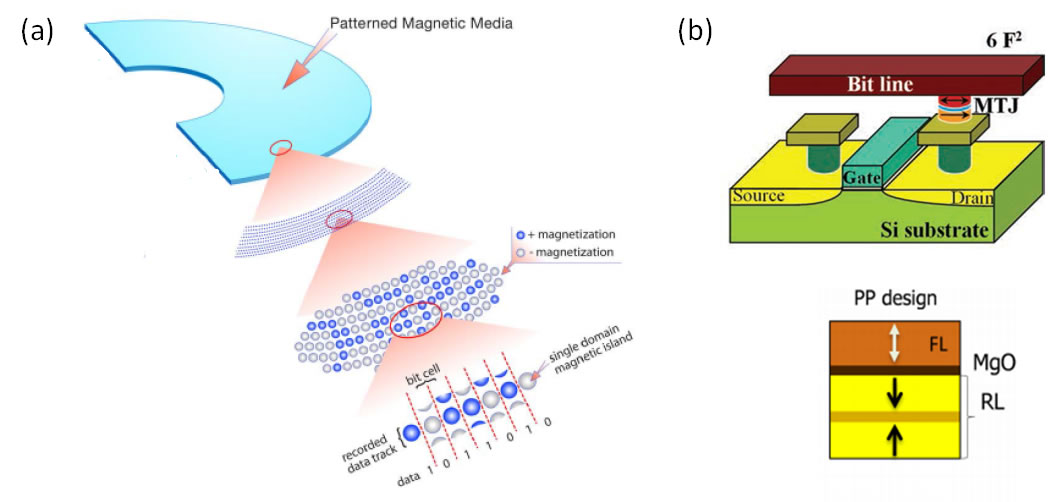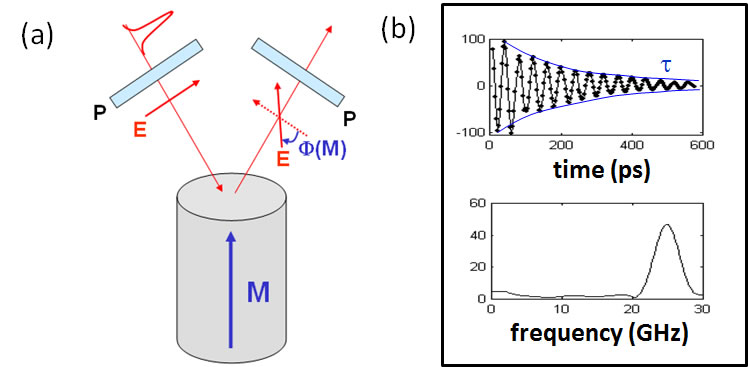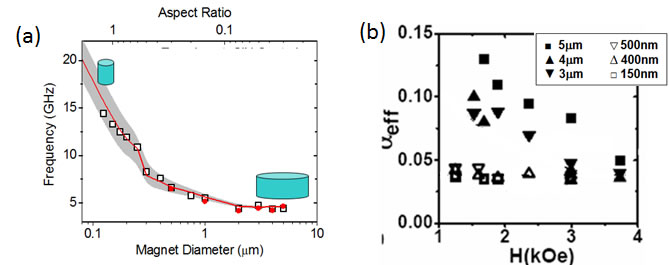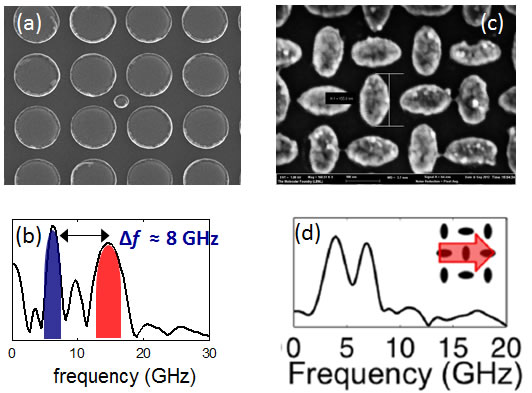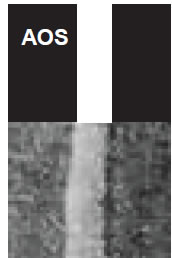 |


|
|||
Magneto-optics of Nanomagnetic Structures: Watching Single Magnets Flip | |||
|
|||
|
Fig. 1: Single FePt nanocap deposited on 100nm silica sphere | |||
|
Nanomagnetism is one of the largest and most rapidly evolving areas of nanoscience and technology. This is due to rapidly developing nanofabrication technology and numerous potential applications ranging from high density data storage to biosensing, including bit-patterned media (BPM) and heat-assisted magnetic recording (HAMR) for next generation hard disk drives as well as spin-torque transfer MRAM (Fig. 2). Emerging spintronic devices are based on densely packed nanomagnet arrays which presents us with numerous exciting research problems:
| |||
|
| |||
|
Fig. 2: Examples for emerging applications of nanomagnetic devices. (a) bit-patterned magnetic data storage (image courtesy of HGST); (b) STT-MRAM. | |||
|
We are interested in observing dynamic processes of the magnetization in magnetic materials, in particular individual single-domain nanomagnets. Being able to resolve a single magnet within a dense array is important as it allows for elimination of ensemble effects (such as averaging or interparticle interactions) and provides access to the intrinsic properties of the material. We use time-resolved MOKE spectroscopy (MOKE=magneto-optic Kerr effect, see Fig. 3) to resolve magnetization changes in nanomagnets with femtosecond resolution. We are working on several issues related to fundamental and practical aspects of these dynamic processes. To this end, we collaborate with international leaders in nanomagnet fabrication and characterization as well as with industrial partners. Additional experimental methods we use in pursuit of this goal include e-beam lithography, metal deposition, atomic/magnetic force microscopy, and near-field microscopy. | |||
|
| |||
|
Fig. 3: (a) MOKE principle; (b) typical time-resolved MOKE signals indicating magnetization precession on the picosecond time scale with corresponding Fourier spectrum. |
|||
Single Nanomagnet Dynamics |
|||
We have reported the first observation of magnetization precession in individual, single-domain nickel nanomagnets [1,2]. This was possible after we had developed methods to increase the weak magneto-optical signal from a single nanomagnet by using a combination of dielectric layers on both the substrate and the magnet itself [3-5] (see Fig. 4). Fig. 4b shows the size dependence of the Kittel mode, showing a strong size dependence as the demagnetization field changes with the magnetic shape on the nanoscale. The damping of the magnetization precession also shows a strong size dependence as additional dissipation channels are opened for large magnets at low applied field [2]. This damping behavior is critical for certain spintronic applications. | |||
|
| |||
|
Fig. 4: (a) Precession mode frequency of single nickel nanomagnets as function of size (after [1]); (b) field dependence of precession damping constant for different magnet sizes (after [2]). | |||
|
We also developed the approach of “dynamic separation” to extract the magnetization dynamics of a single nanomagnet from a dense array using diffraction-limited optics [6,7]. In this technique, the array is designed in such a way that the magnet of interest exhibits a different dynamic response than the surrounding neighbors. Fig. 5a illustrates this technique of “separation by shape” in which a smaller magnet is placed within an array of large ones. The precession frequencies differ strongly (Fig. 5b). This allows for tracking the spin dynamics of the small magnet alone and allowed us to extract the effect of magnetostatic interactions on the dynamics [6]. Fig. 5c shows the case of “separation by orientation”. Here, the elliptical nanomagnets show different dynamics depending on their relative orientation in an applied external field (Fig. 5d). | |||
|
| |||
|
Fig. 5: Dynamic separation of nanomagnet properties. (a,b) separation by size: nanomagnets of different diameter have different precession frequencies allowing for observation of single, small nanomagnet; (c,d) separation by orientation: identical elliptical nanomagnets exhibit different mode frequencies depending on their relative orientation in applied magnetic field. | |||
|
We also investigated the influence of the three-dimensional shape on nanomagnet dynamics [8,9]. In a collaboration with the Albrecht group in Chemnitz, Germany, we compared the dynamic behavior of single, curved and flat nanomagnets of otherwise identical shape (Fig. 6a). It turns out that the curved nanomagnets exhibit a very complex spin wave spectrum with multiple modes (Fig. 6b,c) as the magnet breaks up into regions with different demagnetization fields. This study demonstrated that shape can provide another degree of freedom to tailor the dynamic properties of a nanomagnet. | |||
|
| |||
|
Fig. 6: Dependence of nanomagnet dynamics on 3-D shape: (a) SEM image of isolated FePt nanocap on silica sphere; (b) and (c) field-dependent mode spectra of flat and curved FePt nanodisks (images: calculated distribution of precession activity across elements) (after [8]). | |||
|
All-optical magnetization switching | |||
|
It was recently discovered that the magnetization of a ferrimagnetic GdFeCo film can be switched with an ultrashort laser pulse [10]. This all-optical switching phenomenon has now been observed in a number of materials [11] and is the subject of intensive research, both in regards to the fundamental mechanisms at work as well as for applications as high-speed storage. We are collaborating with the Albrecht group at the University of Augsburg in Germany to investigate all-optical switching in novel materials and specifically the observation of these phenomena in nanostructures (see Fig. 7). | |||
| |||
|
Fig. 7: Example of optical reorientation of magnetization with an ultrafast optical laser pulse. (after [11]). | |||
|
Spintronic STT-MRAM devices | |||
|
A current of spin-polarized electrons can transfer angular momentum to a magnetic layer, resulting in electrically induced reorientation (switching) of such a layer. This spin torque transfer effect is the basis of a new class of magnetic memory devices that can feature outstanding properties such as high operating speed and excellent data retention. A crucial material property for this approach is the Gilbert damping parameter α which determines the switching current required to operate STT-MRAM devices. We are using time-resolved magneto-optics to study α and other critical parameters in collaboration with Samsung Semiconductors. This work is supported by the NSF, the Molecular Foundry at Lawrence Berkeley National Laboratory, and Samsung Semiconductor Inc. Our past and present collaborators include the patterned media group of Bruce Terris at Hitachi Global Storage Technologies, Prof. Manfred Albrecht (University of Augsburg), Prof. Kai Liu (UC Davis), Prof. Eric Fullerton (UC San Diego), Grandis Inc. and the STT-MRAM group at Samsung Semiconductors.
|













